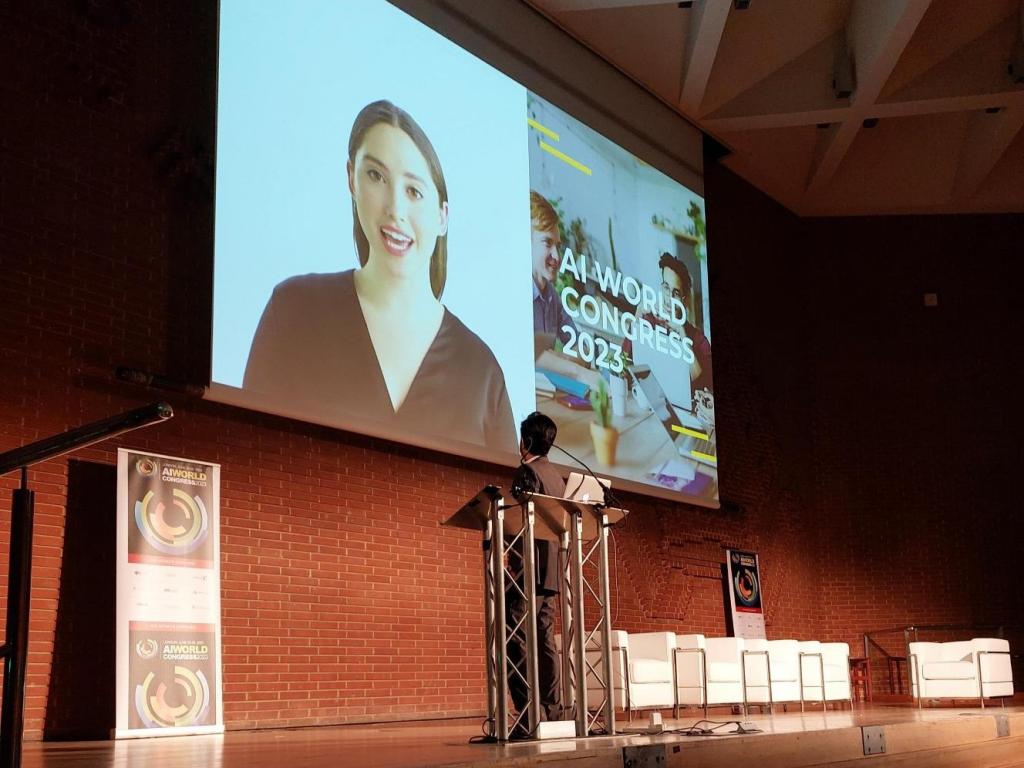The accessibility gap is a pressing issue that arises when individuals' capabilities fall short of the demands placed on them by society. In June I went to London at the AI World Congress to present the authorities thought on how AI could be used to bridge this gap.
The accessibility gap often leads to digital exclusion, particularly in the realm of information and communication technologies (ICT). Bridging this gap requires employing tools and strategies such as assistive technology and universal design to ensure equal access and inclusion for all individuals, regardless of their abilities. I went to London at the AI World Congress to present the authorities thought on how AI could be used to bridge this gap.

The accessibility gap
«London is a roost for every bird.»
This quote by Benjamin Disraeli conveys the inclusivity and diversity of London, what better place for us to speak about how AI can be used to bridge the gap of accessibility than at the AI World Congress in London?
The accessibility gap is a concept that describes the mismatch between the demands placed on individuals by society and those individuals’ abilities or circumstances. Where significant gaps exist, individuals can be excluded – including from digital platforms. This exclusion can be mitigated or overcome by employing various tools and strategies to help bridge this accessibility gap, such as assistive technology and universal design. Universal design aims to create products, services, and environments that are accessible to the widest range of people possible, regardless of their abilities.
The magnitude of the accessibility gap is substantial and affects a significant portion of the population. Individuals with various disabilities, impairments, or limitations may face barriers in accessing and utilizing digital technologies. This includes people with visual or hearing impairments, motor disabilities, psychological disabilities cognitive challenges but also people with temporary disabilities such as broken hands or even just being stressed in a given situation. By ensuring that ICT solutions are accessible to diverse users, regardless of their abilities, we can foster inclusivity and bridge the accessibility gap on a larger scale.
How AI can be used to bridge this gap?
In an ideal world, all digital solutions would be designed with accessibility in mind. But the reality is that universal design of digital platforms has room for improvement. For this reason, the Authority for Universal Design of IKT conducts accessibility testing of major public sector platforms to help ensure that critical digital services are accessible. AI can play a significant role in helping to automate or semi-automate the accessibility testing process – making it possible to dramatically increase the volume of testing without decreasing the quality of results. The rapid development of AI in areas of optical character recognition (OCR), natural language processing (NLP), automatic speech recognition (ASR), and computer vision are particularly exciting as they can directly impact some of the most time-consuming aspects of manual testing.
Some of the ways in which AI can help streamline accessibility testing
Automated testing
AI-powered automated testing tools can scan web content and applications to identify potential accessibility issues. These tools can analyze the HTML, CSS, and other elements of a website or application and provide insights on Web Content Accessibility Guidelines (WCAG) compliance. By leveraging machine learning algorithms, these tools can detect common accessibility issues, such as missing alternative text (alt text) for images, improper heading structure, or lack of keyboard navigation.
Images
AI algorithms can be used to automatically analyze and generate alt text for images and descriptions for multimedia content. By training AI models on diverse image datasets, these algorithms can generate accurate and meaningful alt text, improving the accessibility of visual content for users with visual impairments. Even though these alternative image generators already exist, they have a hard time finding the correct alternative text in context of what the image is used to show.
Captions
Automatic speech recognition system (ASR)
The Whisper ASR (Automatic Speech Recognition) developed by OpenAI has significant potential for automatic captioning, providing accurate and real-time transcriptions of spoken words. Let us see how the Whisper ASR can be effectively utilized for automatic captioning:
Accurate Speech Recognition
The Whisper ASR leverages deep learning techniques and advanced neural network architectures. Trained on large amounts of multilingual and multitask supervised data, Whisper ASR demonstrates good accuracy in transcribing spoken words into text, especially in high resource languages. This accuracy is crucial for generating reliable and precise captions.
Real-Time Captioning
Whisper ASR excels in real-time transcription, enabling automatic captioning during live events, presentations, and real-time communication platforms. The near-instantaneous transcription capability of the Whisper ASR allows for seamless and synchronized captions, providing an inclusive experience for individuals with hearing impairments.
Multilingual Support
Whisper ASR is designed to transcribe speech in multiple languages, making it suitable for global applications. This multilingual support expands the reach of automatic captioning, ensuring accessibility for diverse audiences around the world. While ASRs like Whisper have proven very effective for languages with larger resource bases like English, languages like Norwegian are still not 100%.
Contextual Understanding
The Whisper ASR is trained on a large portion of diverse data, enabling it to comprehend and transcribe spoken language in a contextual manner. This contextual understanding helps the accuracy and readability of the generated captions, resulting in an improved user experience for individuals relying on automatic captioning.
Adaptive Learning
Whisper ASR benefits from ongoing training and fine-tuning, incorporating feedback and data updates to continuously improve its speech recognition capabilities. This adaptive learning process allows the system to adapt to different accents, dialects, and speech patterns, enhancing the accuracy and quality of the generated captions over time, this especially important with the Norwegian audience in mind where every part of the country has a significantly different dialect to the other.
Language and formatting
Natural Language Processing (NLP) algorithms can be utilized to assess the readability and clarity of web content. These algorithms can evaluate the language used, sentence structure, and vocabulary to ensure that the content is easily understandable for users with cognitive or language-related disabilities. NLP techniques can also be applied to suggest improvements in text formatting, including headings, paragraphs, and lists, to enhance readability.
Simulations
AI can simulate the experience of using assistive technologies such as screen readers, magnifiers, or alternative input devices. By simulating these tools, AI algorithms can identify potential barriers that users may encounter while interacting with web content. This helps developers understand and address accessibility issues from the perspective of users with disabilities. While this is not needed to achieve compliance with WCAG yet (Might come in some form with WCAG 3.0), it is always a good thing to test it with assistive technology.
Continuous monitoring and accessibility statement
AI algorithms can be employed to monitor websites and applications continuously, ensuring ongoing compliance with WCAG standards. By periodically scanning the content and analyzing any updates or changes, AI can flag potential accessibility issues and provide recommendations for remediation. This is especially important with the new EU regulations now dictating that every public body in the EU should have an accessibility statement of their solution.
The path forward
It is important to acknowledge that there are risks associated with AI, and it is crucial to be aware of them. One particular concern is that training data, especially for large language models, tends to be based on historical data, which can reflect biases towards certain groups of people, including those with disabilities.
In real-world scenarios, training models on data sets with limited examples of a particular class can result in inadequate performance. This is especially true for rare events such as diagnosing uncommon diseases, identifying manufacturing defects, or detecting fraudulent transactions. Acquiring additional data in such cases can be challenging due to the scarcity of instances. To tackle this issue, one option is to under-sample the majority class by removing rows associated with it, aiming for a balanced representation of both the majority and minority classes. However, this approach has a drawback: the loss of valuable training data, potentially introducing higher bias and compromising accuracy. Another alternative is to over-sample the minority class, which involves replicating instances to augment its presence in the dataset. A promising technique to address class imbalances and rare occurrences is the use of synthetic minority over-sampling technique (SMOTE) and synthetic data generation methods, as highlighted by Nick Baskett of Holland & Barrett. These methods allow for the creation of synthetic data points that resemble the minority class, thereby enriching the dataset and improving model performance.
When utilizing prompt-based AI models such as ChatGPT, it is crucial to recognize that the outputs generated are directly influenced by the prompts provided by the user. It is important to emphasize that any observed bias in AI models does not necessarily originate from the models themselves but rather from faithfully adhering to the given prompts. Instances of bias in AI often arise due to inadequately formulated prompts. In her insightful speech titled "The Art of Prompt Engineering," Bridget Greenwood from The Bigger Pie shared valuable perspectives, offering tips and tricks on effectively harnessing the potential of prompt-based AI models.
To effectively address AI bias, we must recognize that it is just one aspect of a broader problem: biases embedded in our society. While AI models can perpetuate societal biases due to biased training data, it is crucial to understand that these biases originate from existing biases in our society, media, and historical records.
An additional challenge is that AI systems may generate false positives or false negatives, particularly in the early stages of development before they have been exposed to extensive training data. This highlights the need for continuous testing, refinement, and improvement of AI models to mitigate these issues.
Takeaways
Despite the potential harmful effects and challenges associated with AI in the context of accessibility, such as biased data and false positives/negatives, it is important to recognize the significant positive impact AI can have. By incorporating AI in the realm of accessibility, we can improve inclusivity and provide enhanced support for individuals with disabilities.
Being mindful of the risks and challenges is key, it is crucial to foster broader societal awareness, education, and inclusivity to address biases both in AI systems and in our everyday lives. By doing so, we can use the positive potential of AI to bridge the accessibility gap and create a more inclusive and equitable future.
As we strive to make AI technologies more accessible, let us not forget our responsibility to create a future where AI serves as a tool for empowerment and inclusivity, fostering a society that values diversity and respects the rights and dignity of every individual.
The AI World Congress served as a platform to discuss the profound impact of AI amongst other things, on bridging the accessibility gap and fostering inclusivity. As a representative for uutilsynet, I emphasized the transformative potential of AI to empower individuals with disabilities and limited access to resources. By leveraging AI technologies ethically and responsibly, we can create a more accessible world, where everyone has equal opportunities to thrive and contribute. Let us harness the power of AI to build a society that embraces diversity and ensures inclusivity for all.

Jan Beniamin Kwiek
Jan Beniamin Kwiek er teknolog i Tilsynet for universell utforming av ikt i Digitaliseringsdirektoratet.

